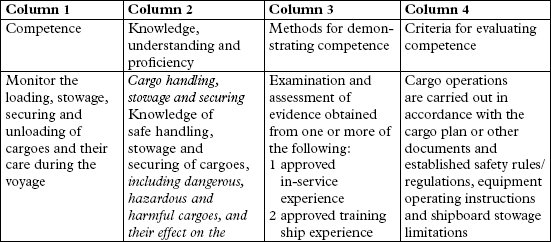International Convention on Standards of Training, Certification and Watchkeeping for Seafarers, 1978

International Convention on Standards of Training, Certification and Watchkeeping for Seafarers, 1978
One of the purposes of the Convention and of the Seafarers’ Training, Certification and Watchkeeping (STCW) Code is to require that seafarers acquire expertise in order to ensure the protection of the environment, as discussed in the following review of their provisions.
1 The Object of the Control of Ships, While in the Ports of a State Party, by Officers of that State
Art. X of the Convention provides in paragraph 1 that ships are subject, while in the ports of a Party, to control by officers duly authorised by that Party to verify that all seafarers serving on board are certificated by the Convention and then provides in paragraph 3 that if the deficiencies referred to in paragraph 3 of Regulation 1/41 are not corrected and it is determined that this fact poses a danger, inter alia, to the environment, the Party carrying out the control shall take steps to ensure that the ship will not sail unless and until such requirements are met to the extent that the danger is removed.
Regulation I/5 of the Annex to the Convention, as amended by the Manila Conference of 2010,2 provides in paragraph 1:
1 Each Party shall establish processes and procedures for the impartial investigation of any reported incompetence, act, omission or compromise to security that may pose a direct threat to safety of life or property at sea or to the marine environment by the holders of certificates or endorsements issued by that Party in connection with their performance of duties related to their certificates and for the withdrawal, suspension and cancellation of such certificates for such cause and for the prevention of fraud.
Regulation I/14, as amended, provides that each Administration shall require every company to ensure, inter alia, that the ship’s complement can effectively coordinate their activities in an emergency situation and in performing functions vital to safety or to the prevention or mitigation of pollution.
2 The Provisions in the Code in which Reference is Made to the Protection of the Environment
The last of the recitals of Resolution 2, by which the Conference has adopted the STCW Code, is so worded:
DESIRING to achieve and maintain the highest practicable standard for the safety of life and property at sea and in port and for the protection of the environment
and reference to the need for the protection of the environment is frequently made in the chapters of the Code as it appears from the review that follows.
Chapter II — Standards regarding the master and deck department
Section A-II/1 — Mandatory minimum requirements for certification of officers in charge of a navigational watch on ships of 500 gross tonnage or more
Table A-II/1 — ‘Specification of minimum standard of competence for officer in charge of a navigational watch on ships of 500 gross tonnage or more’
In respect of the function ‘Controlling the operation of the ship and care for persons on board at the operational level’ the following entries appear:3

and4
Section A-II/2 — Mandatory minimum requirements for certification of masters and chief mates on ships of 500 gross tonnage or more
Paragraph 3 of the introduction so provides:5
3 Bearing in mind that the master has ultimate responsibility for the safety and security of the ship, its passengers, crew and cargo, and for the protection of the marine environment against pollution by the ship, and that a chief mate shall be in a position to assume that responsibility at any time, assessment in these subjects shall be designed to test their ability to assimilate all available information that affects the safety and security of the ship, its passengers, crew or cargo, or the protection of the marine environment.
Table A-II/2 — ‘Specification of minimum standard of competence for masters and chief mates of ships of 500 gross tonnage or more’
In respect of the function ‘Cargo handling and stowage at the management level’, the following entries are made:6

and in respect of the function ‘Controlling the operation of the ship and care for persons on board at the management level’ the following entries are made:7

Table A-II/3 — Specification of minimum standard of competence for officers in charge of a navigational watch and for masters on ships of less than 500 gross tonnage engaged on near-coastal voyages
In respect of the function ‘Cargo handling and stowage at the operational level’ the following entries are made:8


